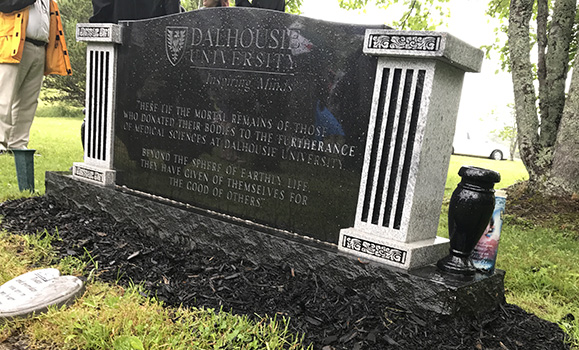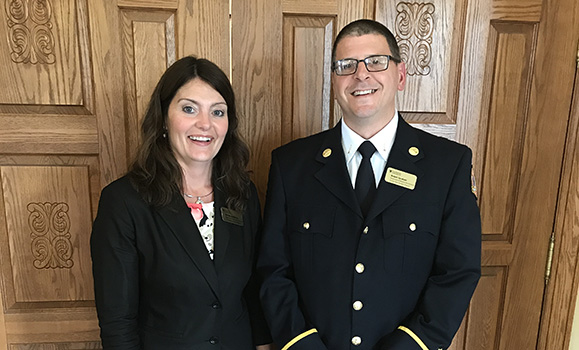“If you are here honouring a parent, please stand,” asks Reverend Jenny Drewitz, Dalhousie multifaith chaplain conducting service at Saint Benedict Parish. “A spouse, please stand. A sibling, please stand. A friend, please stand. Any other loved one, please stand. If anybody is supporting the academics in any way, please stand.”
Following these words, every individual in a room of 700 is standing. The memorial’s ambience offers a feeling of inclusiveness, of shared respect and gratitude for the departed who can’t be present.
Loss brings despair. But on this day in late June, it brought hope.
The occasion was the annual memorial and interment service for Dalhousie University’s Human Body Donation Program. The event pays respect to the more than 150 donors and families who, at some point in the past three years, chose to make the ultimate contribution to medical education and research by agreeing to donate one’s remains to benefit the medical science.
Family and friends felt solace as they sat among those who had shared similar journeys on the way to closure and support.
Stephen Young is the son of the late Sandra Young, a former social worker who made the decision to donate her remains prior to her passing in 2014. Young said sharing a room with families of donors who had made the same decision as his mother Sandra was comforting.
“I felt supported by the many family members and students,” he said. “It was a mutually compassionate audience.”
Silent mentors
Hosted by the Department of Medical Neuroscience, the emotional yet inspirational service provides an opportunity for Dalhousie students from many health disciplines who work in the anatomical laboratory to express their gratitude for the gift of knowledge bestowed by the donors and their families. One by one, 10 students approached the mic to read the names of the deceased, followed by messages of appreciation from four health students and residents.

Piping into the ceremony.
First-year Medical student Jordan Boudreau reflected on his first experience with the donors.
“We were called to reflect on their lives and their roles as family men and women, as lovers and friends,” he told the assembled family members at the memorial service. “We were called to treat every body with the respect and the dignity that everybody deserves in life — the same respect that we extend to one another and ourselves.”
The departed, who are now the silent mentors to many Dalhousie students, are individually unique; they differ in their life experiences, relationships and genetic makeup. Collectively, they share certain beliefs and personality traits that led to their decision to give the ultimate gift to medicine.
“Your loved ones must have possessed certain virtues to defer their interment, their last rites, until today. These humanitarian virtues — generosity, philanthropy, altruism — have come to mind at some time or another as we have worked with them at the university,” said Boudreau.
Donors from all walks of life
Brenda Armstrong, coordinator of the Human Body Donation Program, first attended the service in 1987. She is the first point of contact for families interested in the donation process, and organizes the two annual services.
“For a lot of families, it’s a matter of tradition,” she said. “Their grandparents or parents made the decision to donate. The generosity of our Maritime donors is unbelievable. The service gives families closure. They can pay tribute to their loved one.”
Donors may share a connection to Dalhousie, often as former students, staff or faculty. Some have devoted their lives to a career in health care — former physicians, nurses, or dentists who realized first-hand the importance and value of cadavers through their own educational experience.
Another reason for donating is to give back to the health care system. “Some donors have had various hospitalizations throughout their life, and want to help those with a similar condition,” said Armstrong.
In the case of Sandra Young, she and her sister were diagnosed with an autoimmune disorder, Primary biliary cirrhosis, at a young age. In 1988, she was one of the first to receive a transplant if it’s kind in the province, extending her life for another 26 years.
“Mom really appreciated the opportunity to live the extra years,” said her son, Stephen. “It was that experience that made her think that her body would be useful to medical students. That they would be able to see how the transplant and medications affected her body.”
A medical legacy
Guests at the ceremony receive flower seeds of forget-me-nots, their package adorned with a small dedication: "In memory and tribute to those who donated their bodies to the furtherance of medical sciences and have given of themselves so that others may learn."
Aspiring doctors, dentists, occupational therapists and nurses who learn about basic anatomy in the anatomical lab are mindful of this unique privilege they are granted by the donations. Working with a human body offers an irreplaceable experience and fundamental knowledge for students. It makes their training more practical, leading to superior skills that extend to their ability to treat their patients when they become physicians.

The memorial site to honour donors.
“The gift of the human body transcends being an educational aid,” said Dean of Medicine Dr. David Anderson, also a physician himself. “What’s learned in the anatomy lab has a direct impact on patient care in our hospitals and clinics around the Maritimes. In this way, a donation of one’s body literally becomes the gift of life.”
Each year, medical students recite the Hippocratic Oath, a promise to uphold ethical standards during their time of study and throughout their professional career. An excerpt from the revered text—“I shall ever remember with gratitude my teachers in Medicine”—pays respect to those who teach directly, but for Jordan Boudreau and his fellow classmates, the departed are also teachers in the lab where they study.
“Foremost among our teachers will be your loved ones, the friends and family for whom we have gathered here today,” said Boudreau in his eulogy at the memorial.
Growing potential
“For centuries, the human body has been the foundation for medical advances and improvements in patient care,” said Dean Anderson. “This continues today.”
At Dalhousie University, the gross anatomy laboratory has been in existence and accepting human remains since the late 1800s. Along the hallway on the way to the anatomy lab, portraits taken in several eras share in tradition. The anatomy coordinator stands alongside physicians in training.
A 2016 photograph shows Robert Sandeski, manager of the Human Body Donation Program, standing alongside five medical students in training. He oversees the many students who enter the anatomy lab, while managing learning objectives and resources for students.

Brenda Armstrong and Robert Sandeski, coordinator and manager (respectively) of the Human Body Donation Program.
Sandeski explains that a growing number of cadavers have supported the program each year since the introduction of the Clinical Cadaver Program in 2007, an extension of the Human Body Donation Program. It allows clinicians and other health-care providers to hone their critical skill in a controlled learning environment, focusing on lifesaving procedures.
“The Clinical Cadaver initiative provides an important new link between anatomy teaching and simulation for the clinical learning environment,” said Sandeski.
Though the growth of the program is indicative of its success, there are limitations. Circumstances exist that do not allow for all remains to be accepted; the primary reason is the lack of capacity in a full facility.
“We have a generous environment. The hardest thing we have to do is say no to someone,” said Armstrong. “We have to turn away around 75 applications each year.”
The program may also refuse an application due to issues that interfere with preservation of the remains, such as unhealed surgeries, major traumatic accidents and burns.
* * *
Currently, the program accepts donations from those residing in Nova Scotia, Prince Edward Island and New Brunswick.
Dalhousie Medicine New Brunswick (DMNB) students benefit from laboratory teaching, as a result of the Human Body Donation Program in Halifax, contributing 60+ hours of anatomy training annually at Saint John Regional Hospital in Saint John, New Brunswick.
The DMNB programs’ memorial service is held in early spring in the greater Saint John area.
Learn more: Human Body Donation Program

